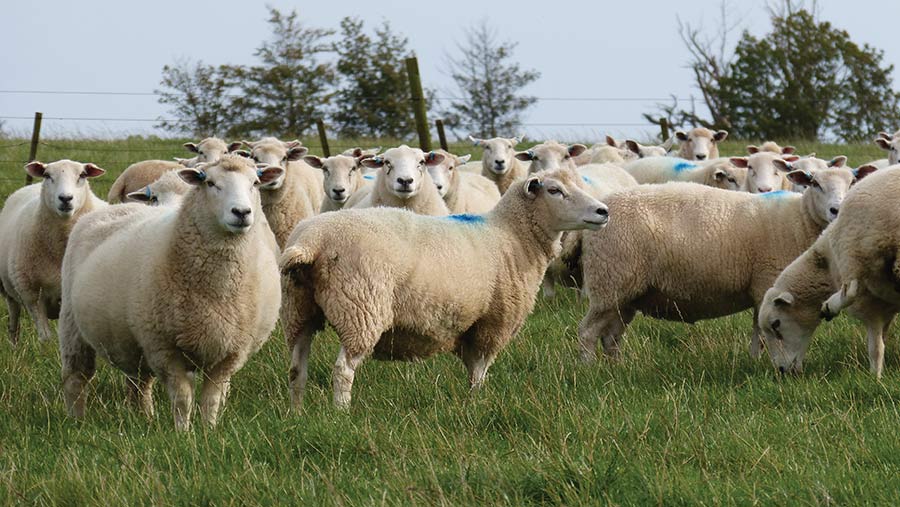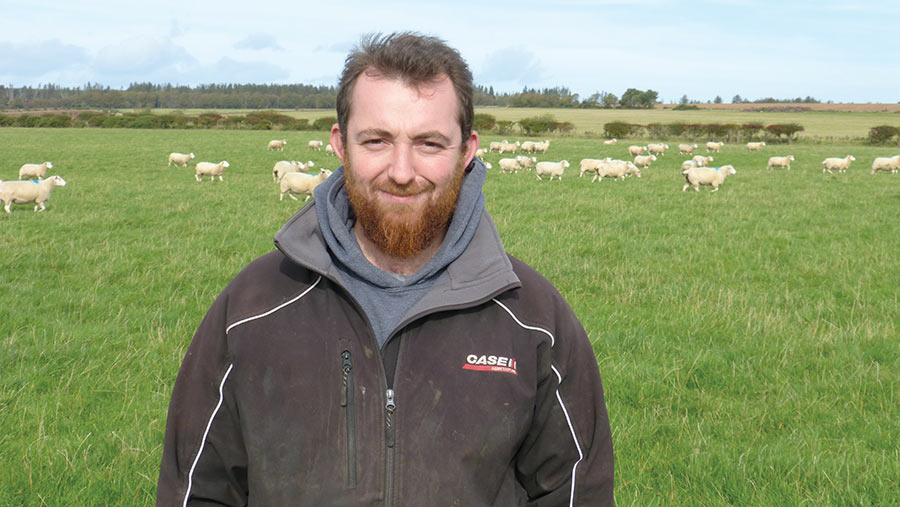Flock genetics beat challenges to hit 170% reared budget
 © MAG/Michael Priestley
© MAG/Michael Priestley Prolific flock genetics and skilful management have overcome setbacks to get a lowland sheep flock hitting budgets, three years after being established.
Farm manager Ben Smith says the accounts at North Falaknowe, Coldingham, on the Berwickshire coast, show upwards of 170% sold for the past two years.
Ben manages the farm for owner David Morrison (James Brown and Co), who farms 15 miles away at a hill farm called Middle Monynut.
Farm facts: North Falaknowe
- 400 Highlanders and 150 Aberfield cross Lleyns
- 15 pedigree Hereford cows
- 121ha, mostly grassland
- Abermax terminal sire and replacements by Highlander ram
- Heavy clay soil type
- One ram to 70-80 ewes
Farm setup
North Falaknowe was bought by David in 2020, following the installation of 142.5MW of wind turbines at Middle Monynut.
These turbines form part of Community Windpower’s Aikengall II and IIa wind farms.
In January 2023, David bought another farm – Bogangreen – a mile from North Falaknowe.
This mainly arable farm grows 1,600 pigs on contracts and 200 Blackface ewes drafted from Middle Monynut, which Ben helps manage in a low-input outdoor lambing system.
“I am given a fairly free reign to manage North Falaknowe and make my own decisions,” explains Ben.
“The aim is to have money left to reinvest in the farm. This year, I budgeted at £90 a head and about 1.7 sold, which we have done.”

Ben Smith © MAG/Michael Priestley
System aims
With profit in mind, the aim at North Falaknowe is to expand to 750 Highlander ewes.
Replacements will be bred to the prolific Highlander ram, which is an Innovis composite that includes Finnsheep genetics.
Dry ewes are given the grass of lowest nutritional quality for a “negative flush”, to keep the scan at about 200% and avoid too many triplets.
Scanning at 200% means the commercial breeding ewes at North Falaknowe have produced 447kg/ha of liveweight lamb before cull ewes, wintering hoggs and cattle are considered.
The sheep run on grass, haylage and mineral lick buckets. Haylage is fed indoors from mid-December, and high-quality silage (11MJ/kg metabolisable energy, 12.4% crude protein) is fed in late gestation before lambing starts on 10 March.
Forage-based genetics and a weekly grazing rotation, achieved by running mobs of 300 sheep, mean that only pet lambs, triplets and very lean ewes are given concentrate feed.
Last year, this totalled 20t, and Ben is aiming at using only 10t this year through better use of forage.
But, while the flock has made a good return for the past two years, Ben explains there have been some major challenges to overcome.
Setback 1: Maedi visna
David bought 400 ewes at a local auction in September, two months after Ben was hired.
They appeared to be fit, but soon, some started losing condition and dying, and flock performance in 2021 was poor (see “Performance of sheep at North Falaknowe”).
Response:
- Two blood tests were done on groups of thin and wasting ewes, and 160 were found to be carrying the chronic wasting disease maedi visna (MV).
- The mixed flock of Cheviot gimmers, Texel crosses and Mules was culled.
- All lambs were fed hard to get them off the farm by September to ensure incoming replacement stock would not be infected. Wintering Blackface hoggs, which had not mixed with the infected sheep, were rushed home.
- MV-accredited sheep were bought in: 390 Aberfield crosses were sourced by Innovis in 2020, about 150 Highlander shearlings were bought from Kevin Stewart, Sharpitlaw, in 2021, and another 140 ewe lambs were bought in 2022.
Table 1: Performance of sheep at North Falaknowe |
|||
|
|
2021 |
2022 |
2023 |
|
Scanning |
120% |
202% |
199% |
|
Sold |
c. 100% |
180% |
173% |
|
Note: Sold figure includes 100 pet lambs in 2023 |
|||
Setback 2: Infrastructure
The farm had previously run cattle, and had limited lambing capacity for about 300 ewes. There were no sheep feed barriers, and all the gates were designed for cattle.
Initially, this was not deemed an issue, as the intention was to outwinter all stock and lamb mostly outdoors.
However, the clay soils could not stand outwintering, and the exposed ridge the farm sits on would have made lambing difficult.
In addition, Covid lockdowns in 2020 delayed the delivery of steel to adapt the main building into a sheep shed.
In the end, the steel arrived two weeks before the lambing season of 2021.
This meant only half the flock could be housed to rest ground. Then, to compound the issue, Storm Arwen flattened two further sheds.
Response:
- In 2021, because of lack of space, single-bearing ewes and some fitter twins from the MV-infected flock were lambed outside from 1 April.
- Lambing date in 2022 was brought forward to 15 March to lamb mainly indoors and turn out quickly to grass that had been rested, by housing most sheep on haylage after Christmas. About 200 later lambers (singles and fit twins) lambed outside. Weather conditions allowed immediate turnout most of the spring.
- In 2023, with two sheds flattened by the storm, a shed at Bogangreen was used to house all stock from December, and all lambing took place indoors.
- A new 500-ewe sheep house with handling system was installed during the summer, and the plan is now to lamb everything at North Falaknowe.
Setback 3: Heavy, magnesium-locked farm
North Falaknowe was known to have heavy soils, but testing revealed a high magnesium level across the farm.
Response:
- A programme of ploughing compacted grassland is underway, with 10ha (24 acres) a year ploughed and drilled with arable, following an initial 20ha (49 acres) in 2022. Two years of barley are followed by herbal leys.
- Gypsum (calcium sulphate) is being applied to the soil at 5t/ha a year. This is to address the magnesium issue, improve the soil’s cation exchange capacity and help open the heavy soil structure.
- Trace elements, humic acid, and Bio-N (a microbial-based fertiliser designed to help plant root structure and nitrogen utilisation) are being applied to improve soil fertility and biology.
- Metabolic profiles are done through blood tests taken three weeks pre-lambing to check fat mobilisation, protein, and trace elements.
- A lick bucket is offered all year, supplying zinc, choline, biotin, selenium, fish oils and other trace elements. Lambs eat any ewe leftovers.
- To ensure other minerals are supplied, ewes get a mineral bolus one month before tupping, and lambs get one at weaning.
Setback 4: Cryptosporidiosis
A rise in mortality in newborn lambs this spring was caused by the parasitic infection cryptosporidiosis, which was traced to one field.
The impact was a drop in lambs sold a ewe to 173%. Ben estimates that without the infection, the flock would have sold 182%.
Response:
- Poor-doing lambs from the affected field were housed, given a glucose drench and an electrolyte in their milk replacer and returned to their mothers if/when they improved.
- In future, lambing fields will be chosen to ensure dry grazing if possible.
